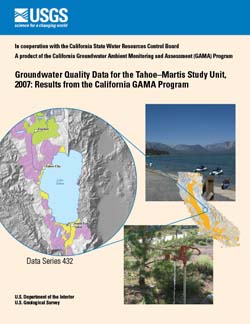 ABSTRACT
ABSTRACT
Groundwater quality in the approximately 460-square-mile Tahoe–Martis study unit was investigated in June through September 2007 as part of the Priority Basin Project of the Groundwater Ambient Monitoring and Assessment (GAMA) Program. The GAMA Priority Basin Project was developed in response to the Groundwater Quality Monitoring Act of 2001 and is being conducted by the U.S. Geological Survey (USGS) in cooperation with the California State Water Resources Control Board (SWRCB).
The study was designed to provide a spatially unbiased assessment of the quality of raw groundwater used for public water supplies within the Tahoe–Martis study unit (Tahoe–Martis) and to facilitate statistically consistent comparisons of groundwater quality throughout California. Samples were collected from 52 wells in El Dorado, Placer, and Nevada Counties. Forty-one of the wells were selected using a spatially distributed, randomized grid-based method to provide statistical representation of the study area (grid wells), and 11 were selected to aid in evaluation of specific water-quality issues (understanding wells).
The groundwater samples were analyzed for a large number of synthetic organic constituents (volatile organic compounds [VOC], pesticides and pesticide degradates, and pharmaceutical compounds), constituents of special interest (perchlorate and N-nitrosodimethylamine [NDMA]), naturally occurring inorganic constituents (nutrients, major and minor ions, and trace elements), radioactive constituents, and microbial indicators. Naturally occurring isotopes (tritium, carbon-14, strontium isotope ratio, and stable isotopes of hydrogen and oxygen of water), and dissolved noble gases also were measured to help identify the sources and ages of the sampled groundwater. In total, 240 constituents and water-quality indicators were investigated.
Three types of quality-control samples (blanks, replicates, and samples for matrix spikes) each were collected at 12 percent of the wells, and the results obtained from these samples were used to evaluate the quality of the data for the groundwater samples. Field blanks rarely contained detectable concentrations of any constituent, suggesting that data for the groundwater samples were not compromised by possible contamination during sample collection, handling or analysis. Differences between replicate samples were within acceptable ranges. Matrix spike recoveries were within acceptable ranges for most compounds.
This study did not attempt to evaluate the quality of water delivered to consumers; after withdrawal from the ground, raw water typically is treated, disinfected, or blended with other waters to maintain water quality. Regulatory thresholds apply to water that is served to the consumer, not to raw groundwater. However, to provide some context for the results, concentrations of constituents measured in the raw groundwater were compared with regulatory and nonregulatory health-based thresholds established by the U.S. Environmental Protection Agency (USEPA) and the California Department of Public Health (CDPH), and with aesthetic and technical thresholds established by CDPH. Comparisons between data collected for this study and drinking-water thresholds are for illustrative purposes only and do not indicate of compliance or noncompliance with regulatory thresholds.
The concentrations of most constituents detected in groundwater samples from the Tahoe–Martis wells were below drinking-water thresholds. Organic compounds (VOCs and pesticides) were detected in about 40 percent of the samples from grid wells, and most concentrations were less than 1/100th of regulatory and nonregulatory health-based thresholds, although the conentration of perchloroethene in one sample was above the USEPA maximum contaminant level (MCL-US). Concentrations of all trace elements and nutrients in samples from grid wells were below regulatory and nonregulatory health-based thresholds, with five exceptions. Concentrations of arsenic were above the MCL-US in 20 percent of the samples from grid wells. Gross alpha particle activity (MCL-US), boron (CDPH notification level, NL-CA), and molybdenum (USEPA lifetime health advisory, HAL-US) were each detected above thresholds in two of the samples from grid wells, and radon (proposed alternative MCL-US) was detected above the threshold in one sample from a grid well. Most of the samples from Tahoe–Martis grid wells had concentrations of major elements, total dissolved solids, and trace elements below the CDPH secondary maximum contaminant levels, nonenforceable thresholds set for aesthetic and technical concerns. Fifteen percent of the samples from grid wells contained iron, manganese, or total dissolved solids at concentrations above these levels.